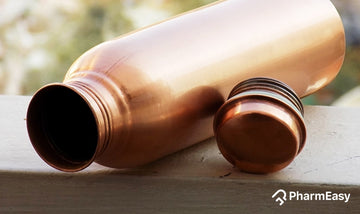
Benefits of Drinking Water Stored in Copper Bottle and Copper Vessels:
When water is stored in a copper vessel or bottle, for eight hours more, copper releases some of its ions in the water, through a process called the Oligodynamic effect. Copper is known to have antimicrobial, anti-inflammatory, anti-carcinogenic and antioxidant properties. It assists in the formation of haemoglobin as well as cell regeneration and unfortunately, the human body cannot create the trace amounts of copper it requires to function healthily, therefore, copper has to be a part of our intake either through food or water, but the human body is benefitted in several other ways with the presence of copper, here are 12+ amazing health benefits of drinking water from a copper bottle:
1) Fights off Cancer:
Copper is a known antioxidant, which means it fights off all the free radicals and negates their negative effects. Free radicals and their harmful effects have been major causes of cancer in the human body. Copper also helps in the production of Melanin which gives colour to one’s skin and eyes, as well protects one from the harmful UV rays of the sun.
2) Balances Hypertension:
According to the American Cancer Society, Copper is known to reduce cholesterol and triglyceride levels. If the Copper deficiency has set on since childhood, it leads to the development of hypotension however, if adults suffer from copper deficiency they develop hypertension. Therefore, trace amounts of copper are critical for the regulation of blood pressure in a person.
3) Aids the Functioning of Thyroid Gland:
According to the experts, the most common feature between patients of the thyroid is copper. Copper balances the inconsistencies of the thyroid gland, that is it energizes the thyroid gland to function well, but it also fights off the damaging effects of too much secretion from the thyroid gland. While lack of copper leads to thyroid gland malfunction, it is also true that too much copper also makes thyroid gland dysfunction causing hyper or hypothyroidism among patients.
4) Prevents Anemia:
Copper assists in the breakdown of food to make haemoglobin, it helps the body in absorbing iron, the deficiency of which causes anaemia. Copper deficiency in the human body can lead to rare haematological disorders which also results in low white blood cells.
5) Cures Arthritis and Inflamed Joints:
Copper has anti-inflammatory properties which provide great relief to patients suffering from arthritis and rheumatoid arthritis. Additionally, copper has bone-strengthening properties, which makes it a perfect cure for arthritis.
6) Negates Infection:
Copper a natural antibiotic, water stored in copper bottles for more than 8 hours is free of all such microbial. Copper is effective against E.Coli, S. aureus and Cholera Bacillus among other common waterborne disease-causing agents.
7) Assists in Digestion:
Ancient Roman texts talk about prescribing copper-based medicine to kill off germs in the stomach. Ayurveda claims that drinking “Tamra Jal” detoxifies and cleanses the stomach. Copper also has properties that stimulate peristalsis (rhythmic expansion and contraction of the stomach lining), reduces the inflammation of the stomach lining and assists in better digestion. Copper is an excellent remedy for stomach ulcers, indigestion and stomach infections.
8) Helps Cardiovascular System:
Copper helps clean plaque as well as dilate the blood vessels to increase the blood flow to the heart. Studies have proved that Copper deficiency can result in the dysfunction of the heart muscles, leading to insufficient pumping of the blood, impaired circulation of blood in the body and the inability to respond correctly to stress.
9) Controls Ageing:
Ancient Egyptians used a lot of copper-based beautifying agents, several skincare products these days are copper-based because copper is not only an antioxidant, it also assists cell regeneration, negating the harmful effects of free agents on the skin.
10) Increases Brain Efficiency:
The human brain interacts with the rest of the body through electrical impulses. Copper helps the cells in communicating with each other by carrying out these impulses, making the brain work much efficiently.
11) Prevents Stroke:
Copper also has anti-convulsive properties which mean copper is an effective means to prevent seizures. Copper also has antioxidant properties, meaning that a lack of copper would enable oxidants in working faster and better, increasing the risk of a stroke.
12) Weight Loss:
Copper plays an instrumental role in dissolving the excess fat deposits in the human body and helps reduce weight. Copper keeps the body in a fat-burning situation even when the individual is resting, however, this does not mean that too much copper will burn more fat; too much copper could end up poisoning the human body.
13) Aids in Healing Wounds Faster:
Copper exhibits anti-inflammatory, antibacterial and antiviral properties. In addition, copper also assists skin regeneration and strengthens the immune system, helping the body in healing wounds faster.
Copper Applications in Health & Environment:
Copper is your friendly neighbourhood superhero as far as its benefits are considered, not just to the human body, but to the environment too. It is a cheap metal, available in abundance as well as easiest to recycle. There are several benefits of copper, here are some to our health and our environment at large:
-
Copper in Health:
A healthy human body requires trace amounts of copper to function effectively. Copper helps with generating heat in the human body, aiding communication between different cells, breaking down certain foods to become haemoglobin and boost our metabolism. Copper deficiency leads to health issues like anaemia, parasitic infections and leaky gut to name a few. Foods rich in copper include sunflower seeds, lentils, dried apricots, mushrooms among others. -
Copper in Environment:
Copper is the friendliest metal in the environment. A good conductor of heat and electricity, Copper is a cheap metal that is also easy to recycle, making it the greenest natural metal. Copper is ideal for making solar panels.
Copper is also the future of nanotechnology, it is interesting to note, that leading IT companies, use copper to make the most powerful computer chips available. In the past few years, copper is being used for bioleaching, a process by which mineral ores are extracted from their sulphide ores with the help of elements present in the environment. Copper also plays an important role in managing hazardous nuclear fuel waste.
Truth About Storing Water in Copper Vessels:
Claims of Copper’s antimicrobial properties have been documented since ancient times. However, without any concrete scientific research, it is difficult to ascertain if these claims are fact or a figment of our collective conscience. To bust this myth, Sudha et al (2012) conducted a series of tests to ascertain the antimicrobial qualities of water. Cultured Cholera bacteria was introduced to water stored in a copper vessel for over 16 hours. Sudha et al reported after several more tests that copper does have an antimicrobial property, as they weren’t able to extract any samples of Cholera bacteria from the water stored in the copper vessel, whereas, the copper content in water was within the permissible range by the WHO standards.
Another study carried out by the University of South Carolina reported that Copper killed 97% of the bacteria present in ICUs, reducing the risk of contracting hospital-acquired infections by 40%. In June 2016, Natural Chemical Biology published another study, proving that copper’s key role in burning fat in the human body. In 2017, U.S. Environmental Protection Agency registered Copper as the only natural metal with properties to kill harmful microbes.
Drinking Water from A Copper Bottle, Correctly and Safely:
Despite all the benefits of copper, one must remember that copper is only required in trace amounts in the human body. One must also remember that too much of a good thing could also become harmful, especially, if we are talking about the delicate balance of human chemistry. Water makes 75% of our anatomy, however, one cannot keep on drinking water stored in a copper vessel, all day and every day. Here are a few tips on drinking water from a copper vessel correctly and safely:
- Buy a vessel or bottle made of pure copper. You can buy the same from Medlife Shop with an assured guarantee* on the purity of the metal*. (As per Manufacturer claims)
- Fill the bottle with water and store it in a cool dry place overnight or all day or for 8 hours.
- Do not refrigerate the bottle.
- The best time to drink water stored in a copper bottle is on an empty stomach in the morning.
- Do not overdo it, drinking water stored in a copper bottle twice a day (morning and evening) is more than enough to provide the necessary amount of copper to your body.
- Take breaks from drinking water stored in a copper bottle. For example, take a month-long break after regularly drinking water stored in a copper bottle for two months. This allows the body to flush out the extra copper.
History of Copper Vessels and Mugs:
The ancient societies didn’t know extensively about bacteria and other harmful micro-organisms, yet, Copper has found its way in nearly all the ancient medical texts. The benefits and various uses of copper have been recorded diligently in ancient texts from all over the world. Ancient Ayurvedic texts claim that drinking water from a copper vessel cures the three doshas of the body namely, Vata, Pitha, & Kapha by positively charging the water. Water stored in a copper vessel for 6-8 eight hours was known as Tamra Jal.
The practice of throwing coins in lakes and landlocked water bodies also find its way back to the time when the mode of currency was copper. Ancient Indians threw copper coins in landlocked water bodies to keep them clean and pure, allowing them to support aquatic life. The practice today has distorted, with people blindly throwing coins made of several other metals into such water bodies, without ever truly understanding the deep science behind cultivating such a practice.
In fact, old house in western countries, including America have copper pipes to this date, it was believed that a glass of tap water then was enough to keep a person healthy. Temples like Rameshwaram, still store Ganga water in large copper vessels ensuring that the water is purified before it is offered to Lord Shiva. Our practices, however, don’t end there, most Indian households have small copper vessels, they use for their daily pooja as well as preparing tulsi-water which is believed to be pure and energising.
FAQ’s about Copper Vessels:
There have been several arguments against using copper vessels for storing water and intaking the same. Here are some of the frequently asked questions about using copper bottles to store water:
-
Will using a copper bottle cause copper toxicity?
Copper Toxicity is caused by using a corroded copper bottle. Copper corrosion can be caused by acidic substances especially food items which are acidic in nature and the softness of the water. -
How long should water be stored in a copper bottle?
Water should be ideally stored for 6-8 hours in a copper bottle to gain maximum benefits from it. -
Can we store anything else in a copper bottle?
No. Only water can be stored in the copper bottle, other substances may have different acidity levels or chemical structure, and copper can react with the same, making it harmful for the human body. -
Can we store hot/cold water in the copper bottle?
It is suggested that the water stored in the copper bottle must be room temperature, neither too hot nor too cold. Temperature can play an inverse role on copper. -
How to clean Copper Bottles?
Pure copper oxidizes when exposed to oxygen and liquids. The best way to clean a copper vessel is to scrub it with lemon juice and salt, to remove the oxidation stains.
The 21st century is reaching out to the wisdom of the ancient world to find answers to modern healthcare concerns. Households, especially in India are going back to employing indigenous household products. One such product is the copper vessel; however, the traditional copper vessel is a large and heavy item, which isn’t compatible with the sleek and space-efficient need of the hour. We at Medlife propose a unique solution to this problem by introducing our range of innovative and designer Copper Bottles, they serve the function of the copper vessel and are sleek enough to be carried in a bag while you are on the move.
News Related to Copper:
Can Drinking Water From Copper Vessels Help Manage Diabetes?
– 06th Nov 2018
The WHO in its health reports has reported that instances of Diabetes doubled in a span of 34 years from being around 4.5% globally in 1980 to nearly 8.4% in 2014. In fact, the WHO has predicted that by 2030, diabetes, would be among the top seven death-causing chronic diseases. The WHO has also voiced fears that the younger population of this century is at an increased risk of developing diabetes. Diabetes is a chronic disease, where the body is either not able to make or utilize insulin properly to help break down blood sugar into energy.
There are several causes that can lead to the development of diabetes in a person, these include lifestyle, obesity, high blood pressure, and so on. Copper vessels have re-entered the market, as the yoga and ayurvedic movement gained momentum. Drinking water stored in a copper vessel for over a period of 8 hours or more has several health benefits, but there is no direct link between drinking water stored in a copper vessel and controlling diabetes. However, researchers have reported that copper deficiency can lead to a rise in diabetes-like symptoms. Researchers also believe that more focused research is required for understanding the relationship between ingesting copper activated water and controlling diabetes.
Breakthrough: Detection of Copper in Environment Made Easy
– 6th Mar 2018
Copper is scientifically proven to be an essential element for the well being of our environment as well as our bodies. This, however, should not translate into overconsumption of copper. In trace amounts, copper benefits the human body, in excess amounts copper is toxic for the body. The U.S. Environmental Protection Committee has set 1.3 ppm copper (Cu2+ ) ion concentration in drinking water as the safe limit for human intake.
This being said, so far, the detection of the amount of copper in drinking water has been a cumbersome and time taking task, which requires large equipment. Recently, Dr Lei Zheng, Dr Hao Qu and Ph. D. candidate Can Xiong from the Hefei University of Technology, China developed a new system that would make the same task easy, less time taking and reduce the size of the equipment involved substantially.
Dr Zheng, Dr Qu and Xiong have combined the properties of Organic electrochemical transistors (OECT) which act as sensors and amplifiers, which have features like biocompatibility, low cost, stability in aqueous systems, portable and real-time sensing of ions, bacteria, cells and so on with the unusual response of poly(3,4-ethylene dioxythiophene): poly(styrene sulfonic acid) (PEDOT: PSS) an organic semiconductor, whose conductivity is increased multiple times when it is exposed to copper (Cu2+ ) ions.
Zheng, Qu and Xiong argue that the fabrication and application of the PEDOT: PSS OECT would create an ultra-sensitive transistor for the detection of copper (Cu2+ ) ions. The PEDOT: PSS OECT can detect the concentration of copper (Cu2+ ) ions for as low as 100 nm which is much lower than the standard set by the U.S. Environmental Protection Committee, making the device cost-effective, portable and efficient.
Copper Coated Uniforms to Prevent Hospital Acquired-Diseases
– 8th Mar 2018
Scientists from the School of Materials, University of Manchester collaborated with their Chinese counterparts in developing a technology to merge Copper (metal) nanoparticles with Fibres (Clothes) to create a washable, diseases resistant piece of cloth, which holds immense promise in the medical field.
In the research paper published in the Journal of Nanomaterials, the researchers explained that this material was developed through a process known as polymer surface grafting which creates strong bonds between the metal and fibre parts. Researchers have used a polymer brush that can bind fibre as well as polymer particles to copper nanoparticles which can withstand 30 washes and more. Copper has proved to have high antibacterial properties and this material will hopefully solve the problem of hospital-acquired diseases, which is rampant in the UK.
The composite material so created, shows resistance to E.Coli as well as S. aureus, the latter is also known as a superbug, resistant to most antibiotics and is generally contracted in a hospital environment, passed down from patient to patient. It is being hoped that uniforms made of this material will provide a safety net to patients, reducing the risk of patients contracting these bacterial diseases from hospitals.
The production of the material, despite the cheap price of copper, is very high, efforts are now being made to bring down the price of production for this material.
Disclaimer: The information included at this site is for educational purposes only and is not intended to be a substitute for medical treatment by a healthcare professional. Because of unique individual needs, the reader should consult their physician to determine the appropriateness of the information for the reader’s situation.




